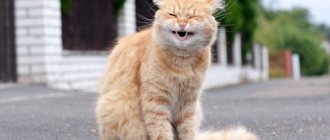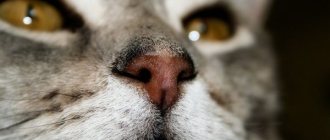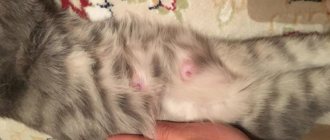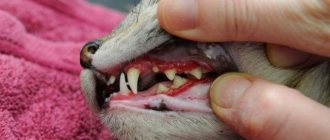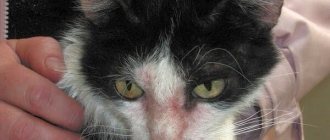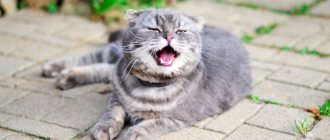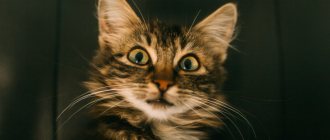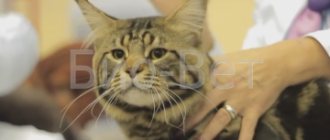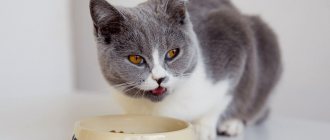Cats are capable of making a wide variety of sounds: from rhythmic purring and gentle meows to prolonged loud howls and snake hisses. The “sound background” depends on the physiological state and emotions, well-being and needs of the pet. Sick cats may cough, sneeze, wheeze, and sniffle. But sometimes the animal makes a sound when breathing, reminiscent of a short snore or grunt. What are the reasons for such a reaction? And is the “grunting state” dangerous to the pet’s health?
Preventive actions
To prevent the listed diseases, one of the symptoms of which is sniffling and grunting in a pet, the following safety measures must be observed:
- Carry out vaccinations and deworming in a timely manner. Such measures will help avoid the development of infectious diseases and the appearance of parasites.
- If your pet has an allergy, eliminate its sources in the apartment and avoid the cat’s contact with allergens outside the home.
- Avoid overeating. Do not leave uneaten food in the bowl. If you gain excess weight, it is recommended to switch your pet to a low-calorie diet. Sterilized cats and neutered cats must be fed special food.
- Avoid hypothermia and overheating of the pet and drafts.
- Increase the animal’s immunity through the regular use of vitamin and mineral complexes, agreed with the veterinarian.
- Conduct regular preventive veterinary examinations to promptly identify existing diseases.
- Start eliminating signs of pathologies immediately after they are identified.
Tracheitis
If a cat grunts loudly, often rubs his nose, coughs, refuses to eat and vomits, it is quite possible that his trachea is inflamed. Hypothermia is a common precursor to tracheitis. If treatment measures are not taken in a timely manner, they lead to aggravation of the disease and the development of bronchitis and pneumonia, in which the use of antibiotics is inevitable. Light grunting and periodic coughing may persist even after recovery, which is due to the specific restoration of damaged tissue.
A cat is like a newborn baby who cannot say what is bothering him and requires emergency help when alarming symptoms appear . In addition to the described reasons that can explain why the kitten grunted, the presence of a foreign body in the respiratory tract, the development of a neoplasm and all kinds of infectious processes cannot be ruled out. Grunting in a cat can be a sign of a dangerous disease, so it is better to consult a veterinarian and conduct a thorough examination.
Pulmonary causes of wheezing
Pulmonary causes can be associated with inflammatory processes in the bronchi and lungs of an allergic and non-allergic nature, and with respiratory tract injuries (foreign body entry, hematomas, pneumohydrothorax, diaphragmatic hernia).
Cats do not get the flu or ARVI. But they have their own viral infections (rhinotracheitis, calcivirosis), which can cause the animal to cough and wheeze.
Rhinotracheitis and calcivirosis
Both diseases are viral in nature and are quite dangerous for cats. Both are accompanied by damage to the mucous membranes of the respiratory tract and intestines. They occur with high fever, diarrhea (in severe cases with dehydration), cough and wheezing. With calcivirosis, the cat's visible mucous membranes and tongue are ulcerated. With rhinotracheitis, there is abundant mucopurulent discharge from the eyes and nose.
Pneumonia
This disease in cats can be bacterial, viral or fungal in nature. At first, a strong “barking” cough appears, as if scratching the airways, and the temperature rises. Then the cough becomes wet with wheezing of large or fine bubbles. The general condition of the animal is impaired.
Bronchial asthma
An animal with this pathology takes a characteristic position: presses against the floor, stretches its neck, makes wheezing sounds, and sometimes coughs. In severe cases, expiratory shortness of breath up to suffocation is observed. With asthma, owners often believe that their animal is choking, which is why it wheezes.
Helminthiasis
Wheezing, similar to symptoms of bronchial asthma, can be caused by the migration of parasites. The most common diseases found in cats are aleurostrongylosis (more common in America) and dirofilariasis.
Oncology
Tumors of the respiratory tract can be benign and malignant, primary and metastatic. Oncopathology of the respiratory system is less common in cats than in dogs. Older animals get sick more often. The development of a tumor in any part of the respiratory tract can cause breathing problems and wheezing. The most common signs of growth of a tumor in the larynx are impaired breathing, difficulty, hoarseness and changes in voice. The pet's voice becomes squeaky or hoarse. The disease is accompanied by shortness of breath and cough, sometimes mixed with blood.
Brachycephalic syndrome
The disease involves pathological growth of the tissues of the velum and narrowing of the nasal passages. The animal wheezes and wheezes heavily. He sleeps with his mouth open and snores. He eats normally. Remains active.
Laryngeal edema, laryngospasm
This condition can develop as a result of poisoning with household chemicals, allergies to inhaled dust, tobacco smoke, strong aromas, etc., an autoimmune reaction. Much less often, mechanical damage to a cat’s larynx leads to laryngospasm. At the same time, the animal’s body feels an acute lack of oxygen and stress hormones are released. The cat is frightened, wheezes and wheezes heavily, breathes with difficulty, whistling, and screams in a “bad” voice.
Pneumo- and hydrothorax
Develops as a result of rupture of the lungs by a tumor, open wound or closed injury. The pet's breathing is difficult, he sits with his mouth wide open, breathes with difficulty and hoarsely, and is very scared.
Inhalation of a foreign object
A foreign body can get stuck in the animal’s pharynx, trachea and bronchi. It may be small and move along the bronchial tree, causing bouts of repeated coughing and wheezing. Or large and block the airways partially (working as a valve) or completely. In this case, the animal coughs, wheezes heavily, rubs its neck on objects, and mucous-foamy sputum, sometimes mixed with blood, is released from the nose. The animal does not drink, does not eat and may suffocate.
Pulmonary edema
Pulmonary edema can be caused by a variety of diseases of internal organs, injuries and inflammation of the lungs, aspiration of vomit, water, and small objects. The cat takes a forced position, breathes hoarsely, with difficulty, pink foam comes out of its nose, and its sides swell.
Congenital pathologies
Narrowing of the nasal passages, an elongated soft palate, and polyps can cause breathing problems and hoarse sounds heard when the animal breathes, especially after exercise.
Tracheal collapse
At the initial stage, it does not cause any particular concern to the animal. Manifests itself in the form of a cough during a strong emotional outburst. Over time, the condition worsens, hoarse breathing appears, shortness of breath, and the cough intensifies.
>The cat whistles with his nose
The animal may lose consciousness.
Allergic manifestations
Allergies are common among tailed pets. An allergen entering the body during breathing provokes an immune system reaction characterized by irritation and inflammation of epithelial cells, swelling of the mucous membrane of the respiratory tract and accumulation of exudate in the bronchi. As a result, the cat:
- has difficulty breathing through the nose;
- breathes through an open mouth;
- makes wheezing, grunting and coughing sounds.
Allergens:
- dust;
- household chemicals;
- chemical preparations for ectoparasites;
- tobacco smoke;
- aerosols and any flavored perfumes;
- cat litter;
- paint and varnish products;
- flower pollen.
Associated symptoms. Difficulty breathing due to allergies is accompanied by:
- sneezing and watery discharge from the nasal passages;
- redness of the eyes and watery eyes;
- itching and the need to constantly rub the face with your paws;
- redness in the throat, dry cough and difficulty swallowing;
- skin and coat problems.
Nature of manifestations. The severity of respiratory allergic manifestations can vary and may include:
- allergic laryngitis and tracheitis;
- allergic bronchitis;
- bronchial ac src=»https://sbc-samaris.ru/wp-content/uploads/posts/pochemu-kot-khryukaet/pochemu-kot-khryukaet_3.jpg» class=»aligncenter» width=»644″ height=» 363″[/img]
In the latter case, the animal suffers from episodic attacks of suffocation caused by bronchospasm, swelling of the respiratory tract mucosa and excessive mucus production by the bronchial epithelium. At such a moment, it seems that the animal cannot take a breath, breathing with wheezing and whistling.
Asthma most often affects adult cats aged 2 years and older.
Methods of therapy. To relieve allergy symptoms, the veterinarian prescribes antihistamines and corticosteroids, and for asthma, special aerosols. An allergic cat must be kept at a comfortable temperature with humidification, preventing the inhalation of dust, tobacco smoke and other substances hazardous to it.
- the cat coughs as if choking;
- colds in cats;
- runny nose in cats.
Signs of wheezing
The cat is coughing: why it wheezes, the reasons, as if it was choking
Wheezing is understood as noisy breathing, against the background of which a combination of many wheezing and whistling sounds is heard. Such deviation from normal breathing is a frequent companion to most pathologies of the animal’s respiratory tract.
Wheezing can occur for two reasons:
- in the process of narrowing the lumen of the respiratory tract;
- due to the accumulation and foaming of fluid in the respiratory system.
Noises and wheezing when breathing do not bode well.
In addition, wheezing means a hoarse, strained voice or its complete absence. This pathology occurs due to incomplete closure of the vocal cords due to the accumulation of mucus in the glottis, which is a common symptom of many inflammatory processes.
The cat is breathing heavily and wheezing
Reasons that lead to loss of voice:
- Respiratory diseases are one of the common causes of wheezing when breathing in a cat. We are talking about various viral and infectious diseases that can be picked up by hypothermia in the cold season. It could be a cold or acute respiratory infection.
- Advanced respiratory diseases can lead to the development of pneumonia, viral feline rhinotracheitis, tonsillitis, calcivirosis or bronchial asthma, a common symptom of which is also loss of voice and wheezing.
- A foreign body in the larynx mechanically damages the surface of the pharynx due to the inability to swallow or regurgitate. This ultimately leads to the cat wheezing when he breathes. A pet can injure its throat with a thin or broken chicken bone, a tree branch, or choking on a spruce needle. Such damage is dangerous due to the high probability of a foreign object entering further into the digestive tract, injuring the upper respiratory tract and esophagus.
- Heart pathology. If the cat begins to show less activity, preferring to lie down instead of playing, walks slowly towards the bowl, as if overcoming obstacles, and upon reaching the goal, chokes, coughs or sneezes, this may be a sign of the development of heart pathologies. Often, owners are not even aware of the onset of heart problems in their cats due to the absence of symptoms. The disease develops, the body reaches a critical point, and after that symptoms appear and increase exponentially. A hoarse cat suffers from severe shortness of breath even after the slightest exertion. She has cold paw pads and ears, pallor of visible mucous membranes (gums, palate, eyes) due to poor blood circulation, in severe advanced cases, audible wheezing in the cat and bubbling in the chest, cold surface of the skin throughout the body.
The cat is trying to vomit a small object stuck in its throat
- Blood pathologies with a lack of iron in the body can also cause difficulty breathing with wheezing.
- With asthma, a cat wheezes and wheezes, presses to the floor, coughs, stretching its neck. As the disease progresses, severe shortness of breath and wheezing, even suffocation, appear.
- Pulmonary edema in a cat is an abnormal accumulation of fluid in the lungs, which is a consequence of various diseases of the internal organs and inflammatory processes. In this case, the cat wheezes when breathing with gurgling. He feels lethargic, phlegmatic, and desires to constantly sleep. The pet opens its mouth slightly with its tongue hanging out when breathing, inflating its belly and sides, trying to squeeze out liquid by coughing and swallowing; when coughing up, traces of blood, a bluish tint to the oral mucosa, and mucus from the nose may appear. A common urge of a cat is to expand its chest by standing in a position with its paws spread wide apart. Deterioration of the condition forces the cat to stretch out on its side.
- The accumulation of large amounts of fluid can be not only in the lungs, but also in the abdominal cavity. This pathology is called abdominal ascites, or dropsy. The pressure of the accumulated fluid compresses the internal organs, disrupting their activity. If dropsy is not treated in time, it can lead to the death of your pet.
Asthma can cause your cat to suffocate if you don't take action.
Breed predisposition
Among the cat breed, there are artificially bred brachycephalic breeds with a shortened muzzle and a flat profile. A small depressed nose, a high forehead and round eyes look very touching, giving the features a childish defenselessness. They have similar anatomy:
- Persian cat;
- exotic shorthair cat;
- Scottish Fold, or Scottish Fold;
- British Shorthair.
Main problems. Along with the doll's charm, the snub-nosed face creates a lot of health problems, in particular:
- Shortened nasal passages are not able to ensure normal air circulation during breathing. Thus, cold air does not have time to warm up, and hot air, on the contrary, cools down in the anatomical cavities, due to which brachycephalic breeds are very vulnerable to the effects of low and high temperatures. After sitting by a slightly open window in winter, such animals can easily catch a cold, and in summer they suffer from overheating. A comfortable temperature for them is considered to be +18-23°C.
- A defect in the nasal septum and broken airways lead to the fact that short-faced cats constantly wheeze when breathing and snore in their sleep, sucking in air forcefully. It is especially difficult to breathe for the so-called “extreme” people, whose facial part of the skull is excessively shortened. Such animals are often unable to eat and drink water on their own, requiring artificial feeding and watering.
- Blockage of the lacrimal glands leads to constant watery eyes or clear mucous discharge from the eyes, which leads to the appearance of skin irritations and brown-colored “tear tracks.” Such streaks are especially noticeable in white and lightly colored individuals.
- The structure of the soft palate of brachycephalics also creates breathing problems. In many individuals, the overgrown mucous membrane sags in a fold and prevents normal air flow. The problem is exacerbated in older animals with decreased muscle tone and congestion in the tissues. At night, such cats can literally suffocate, emitting annoying wheezing and grunting breathing, frightening the owner. Waking up and trying to regulate their breathing, the poor fellows may experience heart palpitations, bouts of painful coughing and vomiting. In order to alleviate the condition, they are recommended to have an operation to correct the shape of the soft palate, during which the veterinarian removes excess mucous membrane, restoring the physiological norm of the respiratory tract.
Treatment of rhinitis
A runny nose and inflammation of the mucous membrane should be treated promptly
, there is no need to wait for complications for your pet to become deaf or for inflammation to spread to other respiratory organs.
If rhinitis occurs due to an infection, bacterial or viral, the veterinarian prescribes antibiotics, antibacterial drugs, taking into account the animal’s age and breed
It is important to strictly adhere to the instructions and carry out the course of treatment to the end, even if there is no discharge and the nose can breathe freely. The course of treatment for rhinitis may include antipyretic, anti-inflammatory, and sedative drugs. Sometimes the veterinarian recommends rinsing the animal’s nose to ease its breathing and general condition. Inhalations with essential oils are effective for rhinitis; you just need to strictly follow the dosage of oil drops. The nose is also warmed up with warm sand or salt wrapped in a clean cloth. If your pet has dry skin around its nose, you can constantly moisturize it with baby cream or Vaseline.
If you need to clear your nose, you should act very carefully and carefully.
, following the advice of experts. Wounds can not only cause pain, but also become a source of infection
. You can clean the crusts with a damp cotton swab.
"Parasitic" problems
It is known that finding a cat that has not had helminths in its life is a task that is almost impossible in practice. It is extremely easy to “pick up” a parasite for a cat - he does not wash his paws with soap. On the contrary, our clean pets constantly lick their fur, to which anything can stick. For example, parasite eggs. Professional veterinarians generally recommend treating their pets with antiparasitic agents at least once a quarter, since otherwise problems cannot be avoided. Moreover, this must be done at intervals of two weeks...
This period is set due to the fact that in nematodes, round parasitic worms (they are the most common in our conditions), one of their life stages grows and develops in the lungs. But this is not what we are more interested in. The fact is that young larvae that parasitize the tissues of the respiratory tract, feeding on their tissues and blood, not only contribute to the introduction of secondary pathogenic microflora, but also contribute to the development of severe inflammation. Because of this, the cat grunts when it breathes, and also makes other “unflattering” sounds.
How can you understand that it was parasites that caused what was happening? It's not that simple here. Some pets show no clinical signs of infection other than coughing at all. But during the period when the larvae begin secondary migration from the lungs to the organs of the gastrointestinal tract, they can be seen in the vomit. At the same time, the cat sniffles and pretends to be a pig so actively that, due to the constant irritation of the vomiting center, it often vomits. Of course, if there is any suspicion that your pet has worms, it must be immediately shown to a veterinarian. An accurate diagnosis of helminthic infestations can only be made based on the results of a stool analysis, and nothing else.
Treating nasal congestion in cats at home
Any owner's heart will break at the sight of a suffering pet. Therefore, it is necessary to know that a person can help his pet at home. To do this you need:
If your cat's runny nose is caused by hypothermia, you need to provide her with warmth and rest.
If you do not know the exact cause of your pet's rhinitis, then the best option would be to consult a specialist. The veterinarian will determine the cause of the animal’s runny nose and draw up a comprehensive treatment plan using various medications.
What happens if your pet's nasal congestion is not treated?
A runny nose can develop into purulent rhinitis
Because of this, the functioning of all organs of the animal may deteriorate. After this, the pet will become passive, the appetite will worsen and the entire body will be exhausted. If acute rhinitis in a pet is not treated, it can develop into chronic rhinitis, which requires long-term treatment and increased care.
Diagnostic methods
To make a preliminary diagnosis and select diagnostic methods, the doctor resorts to the following methods:
- examination of the animal’s upper respiratory tract, mucous membranes, eyes;
- auscultation (listening) of the trachea, bronchi and lungs;
- analysis of data on the conditions of keeping and nutrition of a four-legged patient, information about previous diseases suffered by him, features of the onset of the present pathological process;
- comparison of the animal’s weight with the norm for a given breed and age.
After carrying out the initial diagnostic procedures, the veterinarian prescribes the following types of laboratory and instrumental studies to the four-legged patient:
- clinical, biochemical, virological and bacteriological blood analysis;
- stool examination;
- Ultrasound and electrocardiogram of the heart;
- rhinoscopy;
- bronchoscopy;
- X-ray of the chest organs.
You may also need to consult with specialists. If necessary, the animal is prescribed a dental, oncological and surgical examination. The listed diagnostic procedures are standard. Such procedures are prescribed depending on the clinical picture.
What causes a stuffy nose?
Pets are prone to infectious diseases, since they can often catch a cold while sitting on the floor or in a draft. If a cat has a stuffy nose, the reason may lie at the beginning of the inflammatory process. Only an experienced specialist can make a diagnosis. There you can also get recommendations on treating your pet.
Attention! If there is nasal congestion, it becomes difficult for the animal to assess the surrounding environment, since this organ helps the pet navigate in space and recognize danger. If a cat has a stuffy nose, he experiences a feeling of discomfort
Every owner is obliged to help the animal
Before starting treatment, it is important to determine the cause of this ailment, which may include the following:. If a cat has a stuffy nose, he experiences a feeling of discomfort
Every owner is obliged to help the animal. Before starting treatment, it is important to determine the cause of this ailment, which may include the following:
If a cat has a stuffy nose, he experiences a feeling of discomfort. Every owner is obliged to help the animal
Before starting treatment, it is important to determine the cause of this ailment, which may include the following:
- viral disease;
- the presence of parasites in the body;
- rhinitis, rhinotracheitis or sinusitis;
- hypothermia;
- rotting of the mucous membrane.
Some diseases can be cured on your own, but you need to focus on a well-made diagnosis. In order to cope with severe forms of disease, it is better to consult a veterinarian.
Paroxysmal breathing
This is the name of an interesting pathology when a cat makes very strange sounds during attacks, which can be described as “something in between” sneezing, grunting and trying to inhale more air. How can you determine if your pet has this disorder? It's quite simple: the cat slightly bends its front legs, arches its back, and its eyes are wide open. We have already written about the sounds it makes at this time.
What should the owner do? After all, the cat, it seems, is far from delighted with his condition! No matter how strange it may seem to you, the first thing you should do is calm down. Yes, paroxysmal breathing does not look very pleasant from the outside, but in many cases it does not pose a real threat to the life and health of the animal
.
True, sometimes you should be wary:
If attacks, which were relatively rare and short-lived, acquire an unpleasant tendency to become more frequent.
During “oddities,” the cat begins to vomit, and sometimes blood clots can be easily seen in the vomit.
Your pet has begun to sleep very poorly and restlessly: the cat grunts through its nose, which is why it often wakes up. You need to take a closer look at it if your pet belongs to any of the brachycephalic breeds we have already mentioned.
In the latter case, it is possible that your pet needs the
operation we have already described to “shorten” the palatal tissues
. If everything is not so serious, but you want to help your pet, gently massage his throat after attacks, and also give him plenty of warm water. All this will soften irritated tissues and stop an attack of “grunting”.
A cat's wheezing and snoring indicate abnormalities in its body. They can be caused both by the characteristics of the breed and congenital pathologies, and by various diseases. If such symptoms occur, it is necessary to examine your pet. If there are no signs of deterioration in health, there is no reason to panic. If general malaise and other symptoms appear, the animal should be taken to a veterinarian.
Why this can happen: natural predisposition
If you are the owner of an “English” or a Persian cat, then you will most likely have to come to terms with his “oddities”. The fact is that animals of these breeds belong to the so-called brachycephalic varieties. This is the “scientific” name for mammals that have a shortened head with a characteristic “flat” muzzle.
In the process of breeding such animals, breeders encountered a lot of difficulties. So, the same Persians have a lot of genetic anomalies, many of which are tied to the genome, which provides these animals with a shortened full face of the skull. Whatever one may say, from a natural point of view such a structure is nonsense. In particular, all cats of these varieties are extremely unstable to the effects of very high and low temperatures: the air simply does not have time to warm up or, on the contrary, cool down in their nasal cavity.
In winter, Persians, Britons and cats similar to them constantly catch colds (they should not be allowed outside at all when the ambient temperature drops below 10° Celsius). In the summer, it’s hard and difficult for them to breathe in the heat - hence the “grunting”. Because of this, your pet regularly sneezes when he gets into a dusty room: his respiratory organs simply do not have time to filter everything. But there may be more to it than that.
The problem also lies in the structure of the soft tissues of their palate. Over time, especially in old pets, it can simply “sag,” thereby blocking the normal flow of air. Because of this, the animal becomes even more like a pig. In principle, there is no particular problem here, but... if the grunting becomes incessant, and your cat cannot sleep normally due to “heroic” snoring, we strongly advise you to take him to the veterinarian. It is quite possible that he will need surgery to correct the structure of the soft palate. During the intervention, the surgeon will cut off the “extra” parts that interfere with the normal passage of air. Another sign that “clearly hints” at the need for such a procedure is vomiting, which occurs with particularly strong “grunting”. But there are other causes of grunting breathing, many of which are not so “harmless”.
Why can a cat sniff and grunt when breathing?
Quite often, a cat's breathing is accompanied by wheezing. As a rule, physiological factors act as the causes of this phenomenon. Such snoring should not cause concern to the pet owner.
When an animal is breathing heavily, grunting, sniffling and whistling through its nose, you should immediately show it to a veterinarian. Ignoring these symptoms caused by pathological factors can lead to serious consequences, including the death of the cat.
We invite you to familiarize yourself with Quail meat: benefits and harms
The respiratory system of these animals is similar in structure to humans. They, just like people, can sigh, sniffle, grunt, and snore. In most cases, this occurs due to natural causes and should not be a cause for concern. Your pet's wheezing may appear against the background of:
- Excessive physical activity. In healthy individuals, the respiratory rate depends on the degree of load. A cat breathes most calmly during sleep.
- Nervous shock. Experiencing excitement, fear, rage and excitement, the cat begins to breathe noisily. Breathing may be accompanied by wheezing. This is a short-term condition. It goes away after the source of stress disappears.
- Bearing offspring, feeding young and sexual desire. In all these situations, the cat's breathing quickens.
- Overheating. An overheated pet inhales air not through its nose, but through its mouth. He does it hard, with a whistle. The cat instinctively tries to spread out his whole body on the floor in the coolest room, usually on the tiles in the bathroom.
Among the pathological reasons that a pet is breathing loudly are:
- Swelling of the larynx. This pathological phenomenon most often occurs against the background of an allergic reaction or foreign objects entering the respiratory system.
- Asthma. The symptoms of this disease are difficult to ignore. It is characterized by attacks of suffocation not only at night, but also during the daytime.
- Formation of stones in the organs of the urinary system. In the presence of stones, breathing is often accompanied by wheezing.
- Helminthic infestations. Worms can affect any organs, including the respiratory organs, leading to disruption of their functioning as a result of blockage.
- Inflammation of the lungs and bronchi.
- Inflammatory process in the mucous membranes of the nose.
- Respiratory diseases.
- Heart failure. In this state, the animal not only breathes poorly, but also coughs. Blueness of the mucous membranes is also noted.
- Obesity. Excess body weight leads to increased stress on all organs, including the heart muscle. The chain of pathological reactions gradually results in such phenomena as heavy breathing and snoring.
- Injuries to the chest, spine, ribs. If the animal sticks out its tongue, it is breathing shallowly, it is trying to inhale more air, as if it is suffocating, most likely, breathing is causing it pain.
Varieties
If the owners find that the cat wheezes when he breathes, wheezing and other pathological noises are recorded, then it is worth taking the pet to the veterinarian. Such a violation is divided into several types, presented in the table:
| Type | Peculiarities |
| Fine bubbles | The pathological sound is a consequence of the collapse of small air balls that are formed during sputum |
| Such wheezing is heard when the pet is sleeping or awake, and is characteristic of bronchitis, pneumonia and pulmonary infarction. | |
| Medium bubble | Reminds me of the sound of air blown through a tube |
| Observed with inflammation of the bronchi, which is associated with abundant accumulation of mucus | |
| Large-vesicular | Can be listened to without special devices |
| The cat exhibits noisy breathing with severe wheezing, and the pet can often burp liquid accumulated in the lungs | |
| Caused by pulmonary edema |
Veterinarians note that the cat may experience wheezing, whistling, dry or wet. At the same time, different types of noise are associated with different reasons and require special treatment.
The cat is choking and wheezing: what to do
Seizures in a cat: causes, what to do, treatment
You need to open the mouth and pull the tongue forward, check the throat for foreign objects that should be removed, including mucus or vomit. This will help clear your airways. To do this, hold the cat by its hind legs and raise its head.
Important! If you suspect a spinal injury, you should not lift or move the animal. If removal of the foreign body does not help, you must begin first aid.
If removal of the foreign body does not help, you must begin first aid.
First aid for respiratory arrest
Step-by-step instruction:
How to give artificial respiration to a cat
Start artificial respiration: lay the cat on its side, pull the tongue forward, cover the mouth with your hand and straighten the neck. Air is inhaled through the cat's nose every 3 seconds.
It is important that the chest rises, but does not arch from excess inhaled air. During artificial respiration, you need to check for a heartbeat. If the heart is beating but there is no breathing, you need to inhale air at a rate of 10 breaths per minute until the cat breathes on its own. If you are completely sure of cardiac arrest, begin chest massage. If respiratory arrest is detected and resuscitation begins, it is important that someone call a veterinarian or take the cat and its owner to the clinic.
Important! Cardiopulmonary resuscitation should not be performed if the cat is conscious. Instructions on how to perform chest compressions on a cat
Instructions on how to perform chest compressions on a cat
Helminthiasis
An animal carrying parasitic worms can make unusual grunting sounds.
Toxocara. The development cycle of the Toxocara nematode begins with the cat swallowing food infested with larvae or eating the intermediate host of the parasite, which is:
- mouse;
- rat;
- bird;
- insect.
Development in the body . In the intestine, the larva actively invades the blood vessel through the epithelial wall in order to enter the lungs with the bloodstream. Young parasites feed on the blood and tissues of the airways, causing severe irritation, difficult wheezing breathing and a reflex cough.
The damaging effect leads to the attachment of pathogenic bacteria that increase inflammation. With a cough, some of the larvae enter the oral cavity and are swallowed again, growing in the intestines into a mature worm. During the period of migration of larvae into the digestive tract, the cat may experience the urge to vomit.
Hookworm. Hookworm larvae cause hookworm disease by entering the cat’s body in several ways:
- simultaneously with food and water;
- when self-licking;
- through the skin with subsequent penetration into the bloodstream;
- when eating infected rodents.
Development. The path of larvae that have penetrated through the skin into the blood lies in the respiratory tract, and then, when coughing, into the oral cavity.
After 3 weeks, swallowed parasite embryos grow in the intestines into adult individuals that feed on the blood of the host animal.
Clinical picture of helminthic infestation. Infection with helminths in a cat is indicated by:
- poor appetite and weight loss;
- apathetic behavior;
- disruptions in the gastrointestinal tract;
- increase in abdominal volume;
- the appearance of mucus and blood in feces;
- unkempt appearance, poor coat;
- constant discharge from the eyes;
- pallor of the mucous membranes in the mouth.
Diagnosis and treatment. The diagnosis is based on laboratory tests of blood and feces. Having determined the type of helminth, anthelmintic drugs are prescribed in the required dose and, possibly, with repeated use.
This is interesting: All about parasites in cats
Pre-medical and emergency measures
If wheezing or other alarming symptoms appear, the cat needs veterinary help. Any owner should understand what to do if a cat is breathing with its mouth open, wheezing or choking.
To alleviate your pet’s condition before the doctor begins to treat it, you can take the following measures:
- Humidify the air in the room using a spray bottle.
- Make sure your cat always has the opportunity to drink. In emergency cases, you can help her by injecting water into her mouth using a syringe without a needle. You should first consult with your doctor, since this method of assistance is prohibited for asthma.
After the examination, the cat is given medication, and the recommended dosage is strictly observed. If she has an infectious disease, the doctor will definitely prescribe antibiotics.
It happens that a cat stops breathing after severe wheezing. In this case, you cannot do without chest compressions and artificial respiration.
Execution order:
Place the animal on the floor so that the cervical spine does not deviate from the line of the spinal column. Remove mucus, excess saliva, and foreign objects from the cat’s mouth, and close the animal’s mouth. Fold your palms into a tube and direct air into your nose: 1 minute – 20 breaths. For a kitten: 1 minute – 10 breaths. If the heart cannot be heard, indirect massage should be used
Gently squeeze the cat's chest with your palm and lightly press your thumb just below the armpit. Rhythmically squeeze and release the ribs
Every 5 compressions you need to exhale vigorously into your nose. The restoration of the pulse rhythm is checked after 2–3 minutes.
If a cat develops anxiety, increased salivation, or breathing problems, it is important to find an opportunity to urgently examine the animal by a veterinarian. In order to prevent your pet from wheezing, you need to regularly deworm it, monitor the vitamin composition of its diet, and protect it from injury and hypothermia.
But if the cat does get sick, the best thing you can do for it is to take pre-medical measures to alleviate its physical condition and show it to the veterinarian as soon as possible.
I like1I don't like
Diagnosis of the condition
The cat is breathing with its mouth open: what is the reason and what can be done
If the owner notices that the cat is breathing with difficulty, is very weak, apathetic and does not respond to anything, has severe injuries, has lost weight or has a serious illness (asthma, heart disease, etc.), it is necessary to urgently visit a veterinarian who has the necessary equipment and experience in providing assistance.
A weak, lethargic cat with trouble breathing should definitely be shown to a veterinary clinic.
During the trip, you need to check the cat’s breathing; if you can’t hear it, you can put a mirror against its nose or mouth. A foggy surface is evidence of breathing. You should also check the heartbeat in the chest and the pulse on the inside of the thigh. If breathing or heartbeat stops, you will have to start CPR yourself.
